This was published 10 months ago
‘Something has to change’: Feeling the squeeze of the Big Build’s big bill
By Patrick Hatch and Broede Carmody
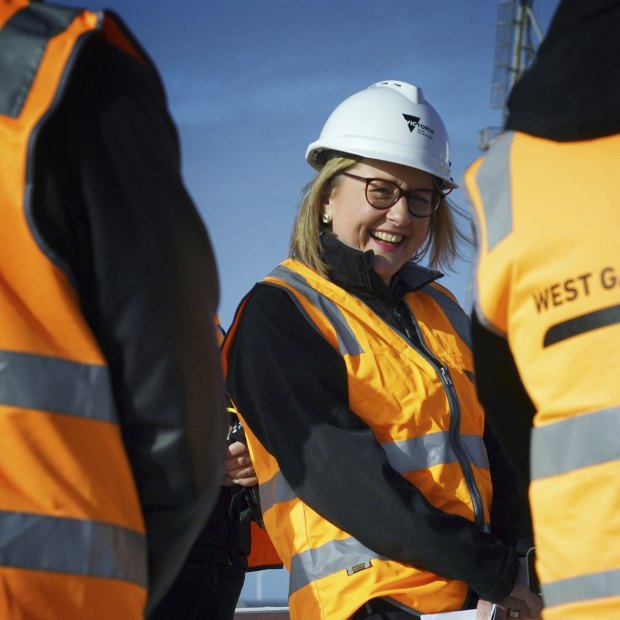
Victorian Premier Jacinta Allan addresses the media at a press conference in Melbourne on Sunday, July 21, 2024Credit: Luis Ascui
When an underground fire broke out in Melbourne’s new Metro Tunnel on Wednesday night, it forced about 80 workers out of the construction site and up to a bustling Swanston Street.
The small blaze was quickly contained, but it’s a tantalising metaphor for the Allan government’s recent woes over its signature Big Build infrastructure mega-program.
The next morning, there was another unexpected and unwanted spot fire.
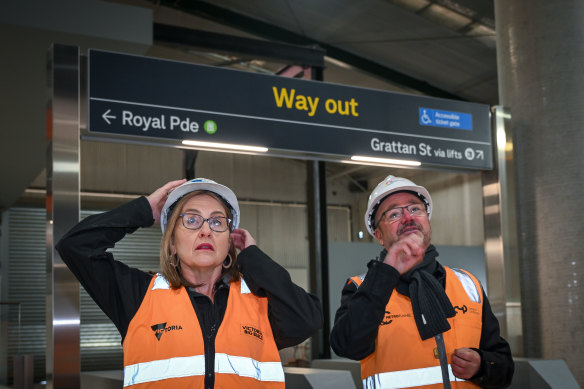
Victorian Deputy Premier Jacinta Allan during a tour of a mock Metro Tunnel station last year. Credit: Eddie Jim
Former CFMEU Victoria boss John Setka made an unauthorised visit to the new State Library station – one stop north on the $14 billion Metro Tunnel – to thumb his nose at the state and federal government attempts to reform the powerful construction union following allegations of corruption and intimidation. The day before, he had popped up at the $1.5 billion Footscray Hospital construction site to deliver an expletive-laden rally address largely targeting the Albanese government and the ACTU.
Premier Jacinta Allan said there was “no place on Victorian Big Build worksites” for the disgraced unionist, but the state opposition claimed it symbolised how the Labor government had lost control of its taxpayer-funded mega projects.
The premier and her government had already weathered weeks of negative headlines about its management of the Metro Tunnel, after The Age revealed the new cross-city rail line faced costly delays and unresolved issues with electromagnetic interference at the Parkville medical precinct.
With the project already $3 billion over budget, the state government in June secretly offered the builders “additional payments” worth up to $888 million if they can open it to passengers by the end of 2025.
And although not yet made public, Department of Transport and Planning secretary Paul Younis – the top bureaucrat overseeing the Big Build for the past six years – told staff he would stand down at the end of the year.
“I will be staying on board to ensure a smooth transition to my replacement, once recruited,” said Younis – who has not publicly revealed why he’s leaving – in an email obtained by The Sunday Age.
There is no suggestion Younis’ departure is related to trouble with the Big Build program.
Since coming to power in 2014, Labor has launched an unprecedented transport infrastructure blitz, removing 84 level crossings with another 26 to go, embarking on the Metro Tunnel, and two massive toll roads: the $10 billion West Gate Tunnel and the now $26 billion North East Link.
The biggest – and most contentious – is the Suburban Rail Loop East, which the state intends to start digging from Cheltenham to Box Hill in 2026 and says will cost $34.5 billion when it is finished in 2035.
The program of investment is reshaping Melbourne and has been central to Allan and her predecessor Daniel Andrews’ pitch to voters as leaders who get things done.
But it has also saddled Victoria with the highest debt of any state, which will soon demand difficult spending decisions. In the corridors of parliament, and in the eyes of voters, Allan and her ministers’ well-worn hardhats are losing their shine.
RedBridge pollster and former Labor strategist Kos Samaras said perceptions of the Big Build had shifted negatively amid the cost-of-living crisis.
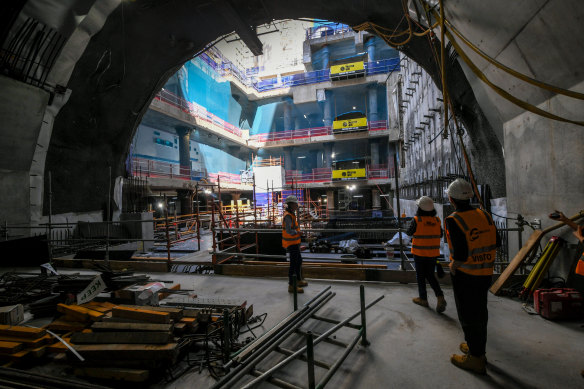
The Town Hall station, part of the Metro Tunnel, which is facing costly delays which threaten its 2025 opening date. Credit: Justin McManus
Victorians, he said, were growing anxious about infrastructure investment crowding out spending on other essential services – particularly health, which was reaching “political crisis levels”.
This came to a head recently when the government talked tough on hospital budgets and even flagged possible health service mergers, only to walk that back and announce an extra $1.5 billion in hospital funding.
“We’re in an era of economic conservatism and people no longer have the appetite to see the government spend money on such large projects,” Samaras said.
“Their mindset has gone from being aspirational to being quite concerned it’s contributing to problems. There’s been a growing sense of concern with Victoria that the deficit will impact on services they care about.”
Laden with infrastructure and pandemic-era emergency spending, budget papers forecast Victoria’s net debt will rise to $187.8 billion by June 2028 – up from $115 billion in 2023 and just $15.8 billion in 2017.
Samaras said the Metro Tunnel and the West Gate Tunnel toll road would be well received when they open next year, as Victorians finally see the benefits of projects that have caused enormous disruption in the CBD and the western suburbs.
But the Suburban Rail Loop East is a double-edged sword, he says: popular in the eastern suburbs but contributing to resentment in outer-western suburbs where voters feel they aren’t getting a fair share of the Big Build bonanza.
Concerns have been simmering for a while. Initially, it was public service traditionalists worried about the project’s secrecy ahead of the 2018 election and then its business case, which was criticised by the state’s auditor general.
In May, concerns were raised at a meeting of MPs from the northern and western suburbs about the SRL hampering the government’s ability to fund other projects.
Melbourne’s northern and western suburbs are Labor’s traditional heartland, but some MPs – while still easily retaining their seats – had their primary vote slashed by more than 10 per cent at the 2022 election.
Eastern suburbs Labor MPs have recently relished the chance to don hard hats and join the premier in touting future train trips to Monash and Deakin universities and brand-new station precincts for Melbourne’s bulging middle ring.
But their western suburbs counterparts – still smarting over the four-year delay to the $13 billion Melbourne Airport Rail project – want similar opportunities to show voters they too are getting results.
They fear what happened to their 2022 vote may become a long-term trend.
“We need big infrastructure projects to say we’re delivering,” one Labor MP told The Sunday Age on the condition of anonymity to speak freely.
But an eastern suburbs Labor MP, also speaking on condition of anonymity, disagreed with their western colleagues’ complaints. “They’re getting the West Gate Tunnel. Every western MP can talk about it.”
They may need to do a lot of talking if things don’t improve by the next state election in November 2026.
Support for the government has dipped to its lowest level in years, with a July survey by Resolve Political Monitor – conducted exclusively for The Age – showing Labor’s primary vote had dropped to just 27 per cent.
The Coalition’s policy is to pause – not scrap – SRL East should they win.
Opposition transport infrastructure spokesman David Southwick said it would be financially irresponsible to simply tear up contracts without the opportunity to examine them closely first.
Still, Southwick insists Labor has put “all its eggs in one basket” with the SRL.
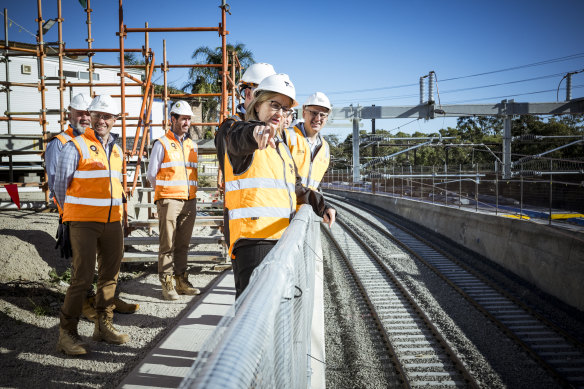
Victoria has launched an unprecedented infrastructure program under Labor, including Level Crossing Removals, the Metro Tunnel and new toll roads.Credit: Chris Hopkins
“If you spend all your money on SRL East, you’re not going to ensure that you’re going to get good infrastructure right across the state,” Southwick said.
“That means a lot of people in Melbourne’s fastest-growing suburbs, particularly in the north and west, just miss out.
“With $35 billion, you can do a lot of things. It’s three and a half airport rails.”
Federal Auditor-General Grant Hehir is expected to hand down his report into the federal government’s $2.2 billion commitment to the SRL by the end of this month.
Victoria has said it expects the Commonwealth to eventually match its funding commitment of almost $12 billion to the project – a request the Albanese government has so far baulked at – while it hopes to raise another $12 billion from unspecified “value capture” property charges.
S&P credit analyst Anthony Walker said the actual cost of SRL East was an unknown hanging over the state’s finances, which are the weakest of any Australian state with “exceptionally large” debt compared with global peers.
The $34.5 billion price tag was estimated in the project business case three years ago – but escalating building material and labour costs have since blown out other major project budgets, including a $10 billion increase for the North East Link revealed last year.
“[The North East Link] also raised some concerns within S&P around the quality of management and the decisions being undertaken, and the risk of further blowouts down the track for other projects,” Walker said.
“The concern from our perspective is that we’re relying on a $34 billion Suburban Rail Loop cost – when are we going to see if that’s being achieved?”
Between 2005 and 2015, Victoria spent an average of $4.9 billion on infrastructure annually.
That has grown steadily to $24 billion this financial year. State budget papers forecast it to remain elevated at an average of $19 billion annually over the following four years, easing to $15.6 billion by 2028.
KPMG chief economist Brendan Rynne said debt-saddled Victoria – squeezed by cost increases and a limited ability to generate new revenue – had no choice but to make tough spending decisions.
Victoria and other east-coast states all built too much major infrastructure at once, Rynne said, which along with COVID-19 disruptions to supply chains and migration, drove up costs and crowded out private projects including housing construction.
“Twelve months ago I built a new house and talked to tradies, and they simply didn’t have enough workers because they were all getting pinched by government projects that paid them more,” he said.
Rynne said the economic reality of the Big Build hangover was starting to be recognised by government, if not yet felt by the community.
“We’ve seen the government look to try to implement some savings reforms within the health portfolio, only to have a political backlash from voters who don’t want to see savings occur in that area,” he said.
“But they’ve got to occur somewhere. Something has to change, it’s plain as day.”
The alternative, Rynne says, is that Victoria’s interest bill – forecast by S&P to rise from $11 million per day in 2023 to $25 million by 2027 – will continue to rise and eventually force spending cuts anyway.
“For every dollar of interest, that’s $1 that can’t be provided to our hospitals, our schools and our roads,” he said.
Rynne said Victoria should consider delaying or rescheduling its remaining major project work to ease demand for materials and workers, while stretching out costs over a longer period.
However, he warned that could actually increase overall construction costs, while pushing back the social benefits of those projects.
Allan has walked back a handful of controversial policies in recent months, including raising the age of criminal responsibility to 14, a safe injecting room in the CBD and the extension of payroll tax to independent GPs.
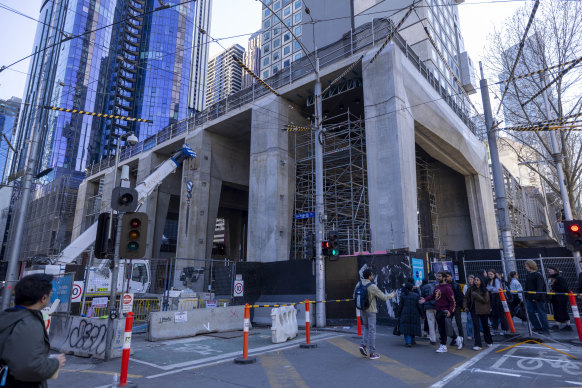
The new State Library train station.Credit: Wayne Taylor
But the state government has hosed down suggestions it had brought in lawyers to explore the possibility of scaling back the SRL.
“The government has not sought advice on cancelling or pausing the Suburban Rail Project and we are not changing or altering any contracts in place,” a spokesperson said last month.
One Labor MP put it more bluntly: “This idea we’re going to back down on the SRL is insane. It’s very popular. People want it.”
If there’s one thing to buoy optimism within the state government, it is Sydneysiders’ euphoric response to the opening of the new $21 billion new Sydney Metro M1 line last month.
Senior Victorian ministers believe there will be a similar level of public excitement when the Metro Tunnel opens 2025 – up to a year out from the next state poll – and that will also help overcome concerns about the SRL.
Allan said this month that the Metro Tunnel would “absolutely transform” the way people move around the city and state.
“It’ll have the capacity to bring half a million people in and out of the city during peak periods every single week. It means people can get to Melbourne University, Peter Mac, the Royal Children’s or Royal Women’s Hospital in a way they’ve not been able to.
“It’ll save time, it’ll save money. It’ll make for quicker, fairer connections right across the state.”
One minister, speaking on the condition of anonymity, told The Age that the popularity of public infrastructure always bounced around before ribbons were cut and that the current crop of Big Build projects were no different.
“The level crossings felt like this in the early days. Now, they are our signature pieces.”
Start the day with a summary of the day’s most important and interesting stories, analysis and insights. Sign up for our Morning Edition newsletter.